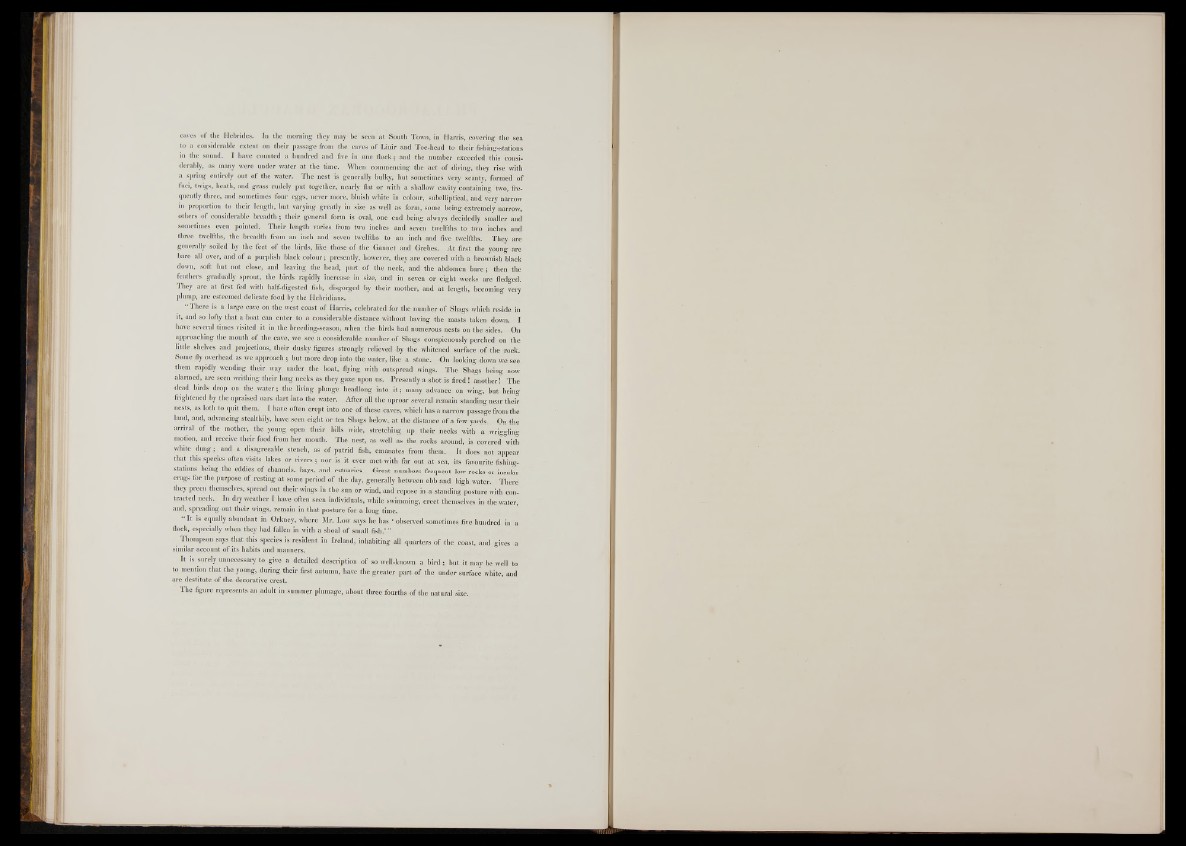
caves of the Hebrides. In the morning they may be seen at South Town, in Harris, covering the sea
to a considerable extent on their passage from the caves of Liuir and Toe-head to their fishing-stations
in the sound. I have counted a hundred and five in one flock; and the number exceeded this considerably,
as many were under water at the time. When commencing the act o f diving, they rise with
a spring entirely out of the water. The nest is generally bulky, but sometimes very scanty, formed of
fuci, twigs, heath, and grass rudely put together, nearly flat or with a shallow cavity containing two, frequently
three, and sometimes four eggs, never more, bluish white in colour, subelliptical, and very narrow
in proportion to their length, but varying greatly in size as well as form, some being extremely narrow,
others o f considerable breadth ; their general form is oval, one end being always decidedly smaller and
sometimes even pointed. Their length varies from two inches and seven twelfths to two inches and
three twelfths, the breadth from an inch and seven twelfths to an inch and five twelfths. They are
generally soiled by the feet o f the birds, like those of the Gannet and Grebes. At first the young are
bare all over, and of a purplish black colour; presently, however, they are covered with a brownish black
down, soft but not close, and leaving the head, part o f the neck, and the abdomen bare; then the
feathers gradually sprout, the birds rapidly increase in size, and in seven or eight weeks are fledged.
They are at first fed with half-digested fish, disgorged by their mother, and at length, becoming very
plump, are esteemed delicate food by the Hebridians.
“ There is a large cave on the west coast o f Harris, celebrated for the number of Shags which reside in
it, and so lofty that a boat can enter to a considerable distance without having the masts taken down. I
have several times visited it in the breeding-season, when the birds had numerous nests on the sides. On
approaching the mouth of the cave, we see a considerable number o f Shags conspicuously perched on the
little shelves and projections, their dusky figures strongly relieved by the whitened surface o f the rock.
Some fly overhead as we approach ; but more drop into the water, like a stone. On looking down we see
them rapidly wending their way under the boat, flying with outspread wings. The Shags being now
alarmed, are seen writhing their long necks as they gaze upon us. Presently a shot is fired! another! The
dead birds drop on the water; the living plunge headlong into.^t; many advance on wing, but being
frightened by the upraised oars dart into the water. After all the uproar several remain standing near their
nests, as loth to quit them. I have often crept into one o f these caves, which has a narrow passage from the
land, and, advancing stealthily, have seen eight or ten Shags below, at the distance o f a few yards. On the
arrival o f the mother, the young open their bills wide, stretching up their necks with a wriggling
motion, and receive their food from her mouth. The nest, as well as the rocks around, is covered- with
white dung; and a disagreeable stench, as o f putrid fish, emanates from them. It does not appear
that this species often visits lakes or rivers; nor is it ever met-with far out at sea, its favourite fishing-
stations being the eddies of channels, bays, and estuaries. Great numbers frequent low rocks or insular
crags for the purpose o f resting at some period o f the day, generally between ebb and high water. There
they preen themselves, spread out their wings iu the sun or wind, and repose in a standing posture with contracted
neck. In dry weather I have often seen individuals, while swimming, erect themselves in the water,
and, spreading out their wings, remain in that posture for a long time.
I It is equally abundant in Orkney, where Mr. Low says he has ‘ observed sometimes five hundred in a
flock, especially when they had fallen in with a shoal o f small fish.’ ”
Thompson says that this species is resident in Ireland, inhabiting all quarters o f the coast, and gives a
similar account o f its habits and manners.
It is surely unnecessary to gire a detailed description o f so well-known a bird; but it may be well to
to mention that the yonng, during their first autumn, hare the greater part o f the under surface white, and
are destitute o f the decorative crest.
The figure represents an adult in summer plumage, about three fourths o f the natural size.